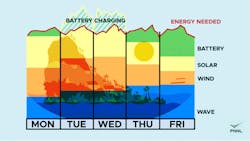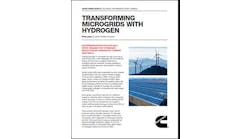Efforts to optimize resilience in microgrids involve evaluating a number of factors, among them available generating resources, location of the proposed microgrid, the likelihood of outages and the status of the existing distribution system. That’s the word from two national laboratories that have separately developed tools and conducted studies to determine how to best optimize microgrids for resilience.
With the first tool, from Pacific Northwest National Laboratory (PNNL), the goal is to add more renewable generation to achieve zero-carbon emissions. The second tool, from Sandia National Laboratories, maps which portions of a distribution system can most benefit from microgrids to achieve resilience. The tool also helps identify sites for microgrids.
Using its Microgrid Component Optimization for Resilience tool (MCOR), PNNL simulated microgrid operation in islanded conditions with different combinations of wave energy, photovoltaics (PV), wind, storage and fuel resources required to meet resilience objectives on the Hawaiian island of Moloka’i, according to a PNNL paper, “Evaluating the Resilience Benefits of Marine Energy in Microgrids.”
“MCOR uses a statistical model to simulate PV resources under a wide range of potential grid outage conditions, simulates microgrid operation for each of those profiles, and returns several different combinations of resources (including PV, batteries and diesel generators) that can meet a site’s electrical loads under all simulated outage conditions,” according to the paper.
The configurations range from nearly 100% renewable generation to configurations that are more reliant on diesel generation, said the paper.
The value of predictable waves
In the Moloka’i study, PNNL researchers looked at how adding wave energy to a microgrid on the island can contribute to reducing or eliminating existing biofuel generation and produce a zero-emission microgrid. The study also investigated how wave energy could avoid the oversizing of PV and battery systems to meet outage conditions or high demand.
“The key takeaway: Adding more types of resources can create a more resilient microgrid that can meet load for more hours and decrease reliance on backup generators,” said Sarah Newman, a PNNL data scientist and co-author of the report. “Different types of resources will give you a more resilient microgrid because you’re not relying on the same type of generation all day.”
Integrated PV, wind and battery storage systems can help cut reliance on diesel generators and aid in maintaining a continuous power supply for longer periods, the paper said.
But PV, wind and storage carry high upfront costs and must be oversized compared to electricity demands to ensure that enough power is available during energy emergencies and outages. And they can’t be relied on to provide uninterrupted power supply because of the intermittent nature of local PV and wind resources, and limitations on the amount of energy that can be stored in on-site battery storage systems, according to the paper.
Marine energy resources, on the other hand, are very predictable and reliable when compared to other renewables such as wind and PV, the paper said.
In this case, the researchers used the MCOR tool to complete 100 simulations of an outage lasting 14 days on the island of Moloka’i. MCOR produced 100 different PV outage profiles. “The outage periods start at different times during the year and include a large variation in PV resource availability as modeled by MCOR,” the paper said.
The researchers modeled a base microgrid system with 3.5 MW of PV, 5 MW of wind, a 17-MW/136-MWh battery and a biofuel generator that helped meet the load for Moloka’i.
“Several sets of simulations were run to explore how incorporating additional renewable energy resources into this baseline system (made up of PV, wind and energy storage) could reduce or eliminate the reliance on biofuel, thus reducing emissions or providing a zero-emission microgrid that uses only generating resources with no outside dependencies,” said the paper.
The analysis showed how marine energy resources could indeed help the Moloka’i microgrid attain zero-emission goals.
Incorporating wave resources into a baseline PV, wind, battery energy storage and biofuel microgrid meant that 15% to 47% less additional capacity was needed to meet zero-emission goals, compared to adding more PV to meet the goals.
A greater diversity of renewable resources that produce power during complementary periods — as opposed to all at the same time — can create a more redundant, resilient microgrid and require less generation capacity, the paper said.
The study can inform efforts focused on remote grids and island grids, which cannot rely on a larger grid or easily available fuels during outages, said the PNNL paper.
The researchers found that adding marine-based renewables could reduce the size of energy storage systems by 17% and cut the cost of the battery, said Newman.
Finding best locations for microgrids
In the Sandia National Laboratories study, Amanda Wachtel, senior analyst in the mathematical analysis and decision sciences department at Sandia, described the resilient node cluster analysis tool (ReNCAT). The goal of the tool is to help planners choose the best locations for microgrids in an effort to ensure that critical services stay powered during outages. The tool identifies which sections of distribution lines should be powered with microgrids during grid outages. These lines support critical services.
Energy planners, communities and infrastructure owners need such computational approaches to make the most of resilience investments, Wachtel said in an abstract of her study.
ReNCAT can lend understanding to the trade-offs between keeping one critical asset online versus another. It can also identify the benefits of keeping specific critical infrastructure powered in large geographic areas such as cities.
“With computational capabilities, it becomes possible to prioritize energy resilience investments that minimize the social burden of meeting human needs during disasters while also minimizing the cost to keep these facilities powered during outages,” Wachtel said in her abstract.
ReNCAT identifies critical and noncritical loads as well as existing power generation that can be used while operating islanded from the grid.
“The objective of the optimization is to minimize the cost of multimicrogrid portfolios while also minimizing the human effort required to acquire critical services,” Wachtel said in the abstract.
Finding the best use of resilience funds
“Cities and organizations have limited funding for resilience investments. Using a tool such as ReNCAT enables them to understand the different options for enabling services during emergency events by using microgrids, and where those microgrids should be located,” said the abstract.
Wachtel is the co-author of another Sandia National Laboratories report, “Analysis of Microgrid Locations Benefitting Community Resilience for Puerto Rico.” The report details how the tool was used to map critical infrastructure in Puerto Rico.
“To improve resilience, Sandia performed an analysis of where clusters of critical infrastructure are located and used these suggested resilience node locations to create a portfolio of 159 microgrid options throughout Puerto Rico,” said the abstract of the study.
Part of the study involved looking at a hypothetical hurricane disruption centered around San Juan, Puerto Rico. The team evaluated placing a microgrid in one of the municipalities affected by the hurricane and showed that different locations avoided different economic losses.
The study pointed to the need for stakeholders to evaluate alternatives and potentially negotiate compromise solutions. “This would become even more necessary if the evaluation metrics would include noneconomic metrics such as measures of access to basic utility and economic services, clean water, food provisions, etc.,” the study said.
The bottom line: By using tools such as the two from PNNL and Sandia National Laboratories, microgrid design can yield more resilient, economically feasible and environmentally sound microgrids that can help communities better cope with outages and disasters.
Track news about microgrids. Subscribe to the free Microgrid Knowledge Newsletter.








